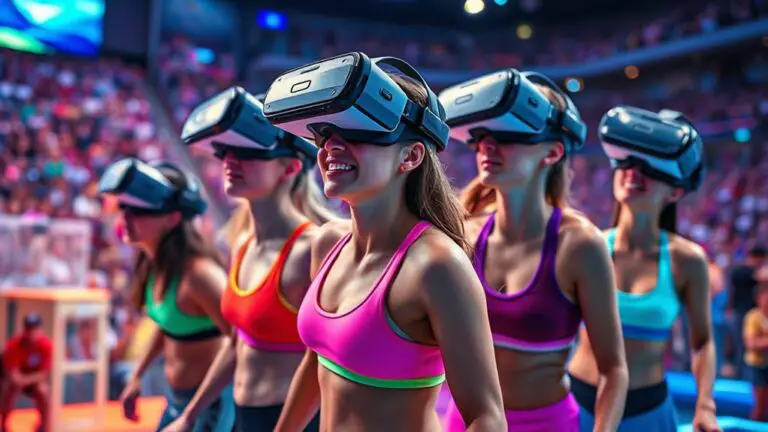Wearable Tech for Gym Performance: What Works?
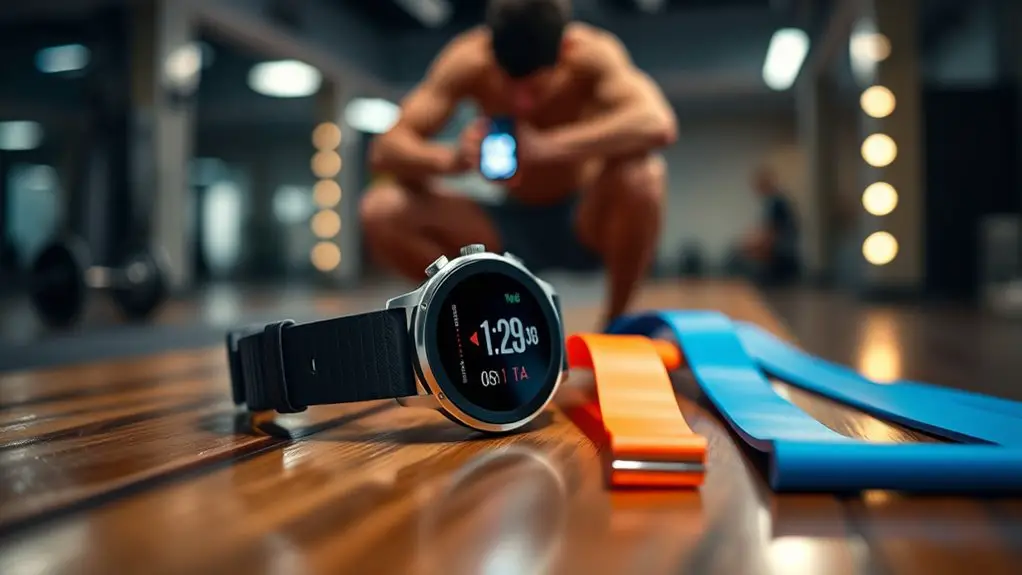
Wearable tech greatly enhances your gym performance. Smartwatches and heart rate monitors provide real-time feedback on your heart rate and recovery, ensuring safe and effective workouts. Fitness trackers help you monitor daily activity levels, while smart clothing offers advanced metrics on muscle exertion and posture. By integrating these devices into your routine, you can make informed decisions about your training intensity and overall fitness. Keep exploring to uncover more about optimizing your gym experience with wearables.
Understanding Wearable Technology in Fitness
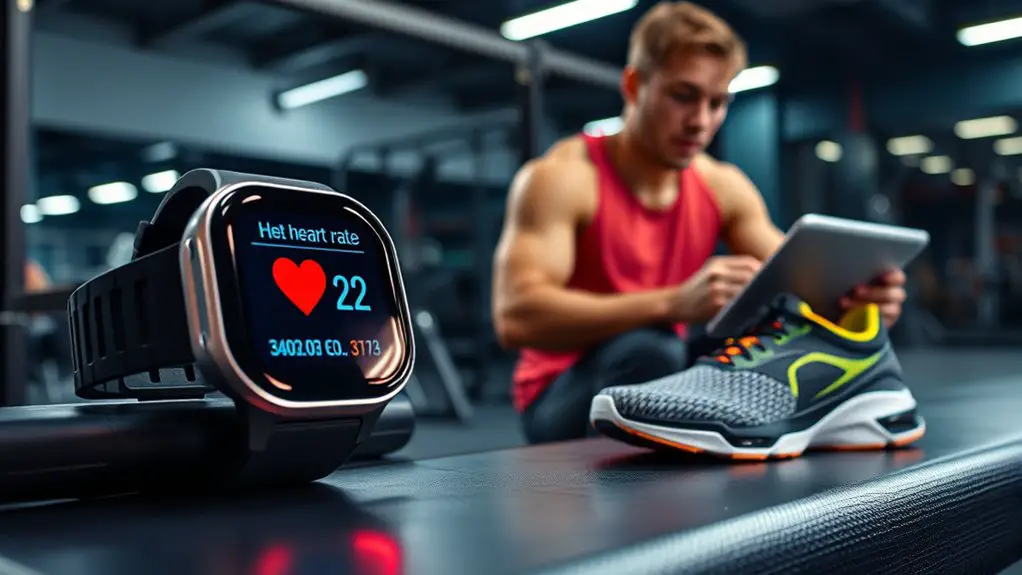
As you immerse yourself in the world of fitness, understanding wearable technology can greatly enhance your gym performance. These devices come with numerous wearable benefits, allowing you to monitor your heart rate, track calories burned, and analyze your workout patterns in real-time. Staying aware of your body’s signals helps you prevent injuries and guarantees you’re exercising safely.
Keeping an eye on technology trends is essential, as advancements can improve your fitness routine. For instance, newer wearables often incorporate features like stress monitoring and sleep tracking, assuring you’re not just pushing hard but recovering well too. By embracing this tech, you can make informed decisions about your workouts, adjusting your intensity based on your body’s feedback. So, whether you’re lifting weights or doing cardio, integrating wearable technology into your fitness journey can help you stay safe and achieve your goals more effectively.
Smartwatches: Features and Benefits for Gym Enthusiasts
Smartwatches can greatly enhance your gym experience with their impressive health monitoring capabilities and workout tracking features. You’ll appreciate how these devices keep you connected and compatible with various fitness apps and devices. Let’s explore how these benefits can improve your performance and help you reach your fitness goals.
Health Monitoring Capabilities
While you’re pushing your limits at the gym, health monitoring capabilities in smartwatches can provide invaluable insights into your performance. These devices offer biometric feedback, tracking heart rate, oxygen levels, and stress, which helps you guarantee you’re not overexerting yourself. By keeping an eye on these metrics, you can make informed decisions to optimize your workouts and maintain safety. Additionally, sleep analysis features allow you to monitor your rest patterns, assuring you’re recovering properly for future sessions. Quality sleep is essential for peak performance, and understanding your sleep cycles can help you avoid burnout. With these tools, you can enhance your training while prioritizing your health and well-being.
Workout Tracking Features
Many gym enthusiasts find that workout tracking features in smartwatches can considerably enhance their training experience. These devices offer various workout metrics, such as heart rate, calories burned, and distance traveled, helping you monitor your performance effectively. With real-time feedback, you can adjust your intensity and avoid overexertion, ensuring your safety during workouts. Performance analytics provide insights into your progress, allowing you to set achievable goals and make informed decisions. By analyzing trends in your data, you can identify areas needing improvement and celebrate your successes. Overall, integrating these features into your routine not only boosts motivation but also fosters a safer, more productive workout environment. Embracing technology can propel your fitness journey to new heights.
Connectivity and Compatibility
When it comes to maximizing your gym experience, connectivity and compatibility are essential features to take into account in wearable tech. You want your smartwatch to seamlessly integrate with other devices, ensuring smooth device interoperability. This means you can easily track your heart rate, calories burned, and workouts without worrying about compatibility issues. A smartwatch with strong software integration can sync data with fitness apps, providing real-time insights on your performance and progress. Plus, it enhances safety by allowing you to monitor your health metrics closely. With the right connectivity, you can focus on your workout, knowing your wearable tech is working effectively alongside your other devices for peak performance and safety.
Heart Rate Monitors: Tracking Intensity and Recovery
Heart rate monitors have become essential tools for anyone serious about maximizing their gym performance. By tracking your heart rate variability, you can gain insights into your intensity levels and guarantee ideal recovery. Keeping an eye on your heart rate not only helps you stay safe during workouts but also aids in recovery enhancement.
| Metric | Importance |
|---|---|
| Resting Heart Rate | Indicates overall fitness level |
| Maximum Heart Rate | Helps determine workout intensity |
| Recovery Heart Rate | Indicates how quickly you recover |
| Heart Rate Variability | Reflects stress and recovery status |
| Average Heart Rate | Provides insight into workout effectiveness |
Utilizing these metrics enables you to tailor your workouts better, guaranteeing you’re pushing hard enough without overexerting yourself. With the right heart rate monitor, you’ll make smarter training decisions that promote both performance and safety.
Fitness Trackers: Monitoring Daily Activity and Progress
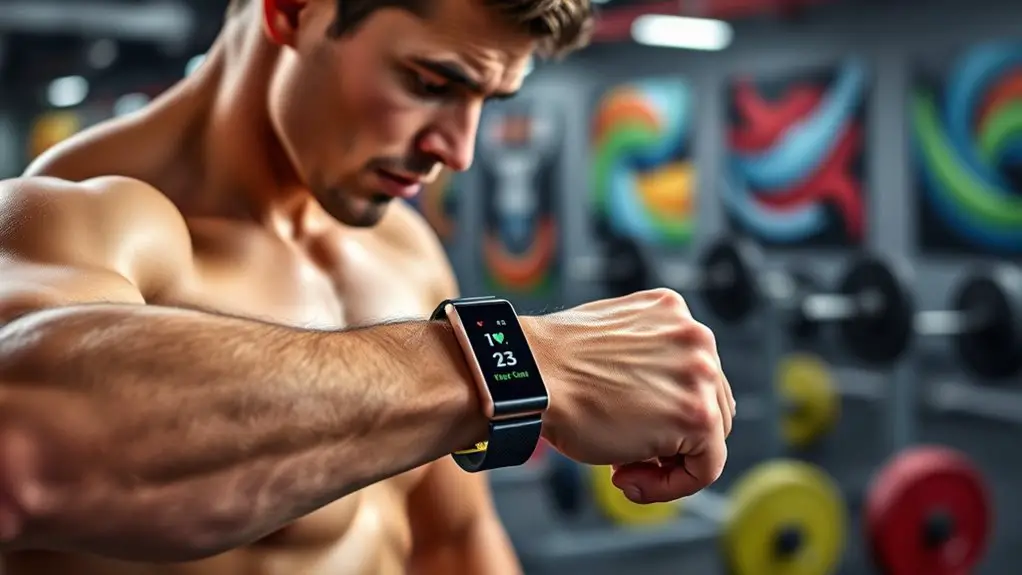
Fitness trackers are essential tools for monitoring your daily activity and progress. They not only keep tabs on your daily steps but also provide insights into your heart rate, helping you understand your fitness levels over time. With this data, you can make informed adjustments to reach your health goals more effectively.
Daily Step Tracking
As you endeavor to improve your gym performance, tracking your daily steps can provide valuable insights into your overall activity levels. Setting specific step goals can motivate you to stay active throughout the day, ensuring you’re moving enough to complement your workouts. Fitness trackers can send you activity reminders, nudging you to get up and walk if you’ve been stationary for too long. This not only helps you reach your step targets but also promotes better circulation and reduces the risk of injury. By monitoring your daily steps, you can assess how your activity aligns with your fitness aspirations, making adjustments as needed for a balanced approach to health and performance. Prioritizing safety in your activity can lead to lasting results.
Heart Rate Monitoring
While you’re crushing your workouts, keeping an eye on your heart rate can provide essential data about your performance and intensity levels. Heart rate monitoring helps you guarantee you’re training safely, allowing for continuous monitoring of how hard your body’s working. By tracking your heart rate variability, you can gain insights into your recovery and overall cardiovascular health. If you notice your heart rate staying elevated or fluctuating too much, it might be a sign to adjust your workout intensity or take a rest day. Using a fitness tracker for heart rate monitoring not only enhances your training but also promotes safety, helping you push your limits while staying within a healthy range. Stay informed, and train smart!
Progress Over Time
To truly understand your fitness journey, tracking your daily activity and progress is essential. Fitness trackers can provide valuable insights through progress tracking and performance analytics, helping you stay safe while pushing your limits. Here are some benefits of using wearable tech:
- Monitor Daily Steps: Keep an eye on your movement and guarantee you’re staying active.
- Set Realistic Goals: Establish achievable targets based on your current fitness level.
- Analyze Sleep Patterns: Understand how your rest impacts performance and recovery.
- Track Workouts: Log your exercises to see improvements over time and adjust as needed.
Smart Clothing and Accessories: The Future of Wearable Tech
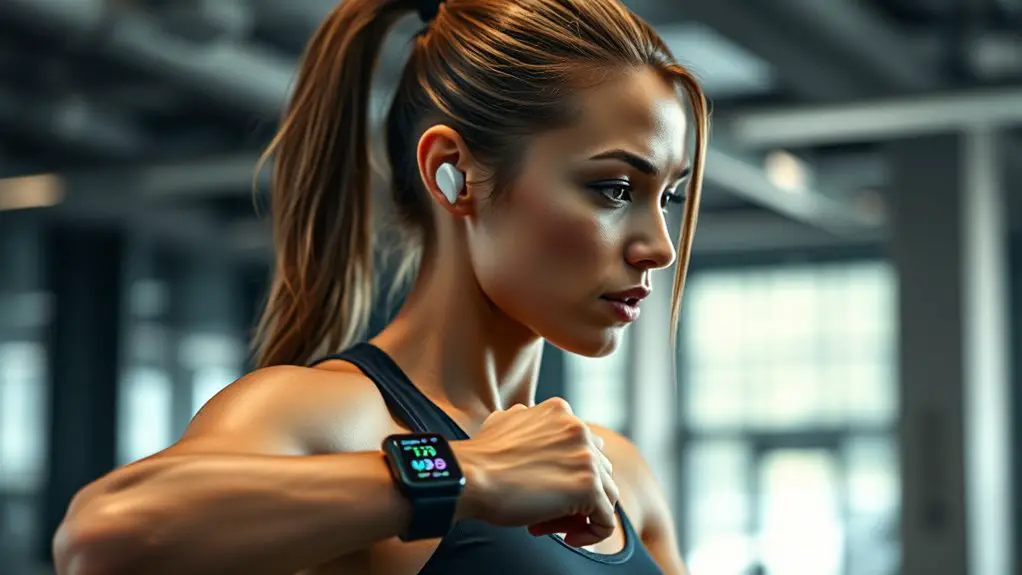
Smart clothing and accessories are revolutionizing the way you approach fitness, blending technology seamlessly with your workout routine. With smart fabrics embedded with sensors, you can monitor your heart rate, muscle exertion, and even hydration levels in real-time. This adaptive technology not only keeps you informed but also enhances your safety during workouts. Imagine receiving alerts if your body is overexerting itself or if you need to hydrate more.
These innovations guarantee that you’re getting the most out of your sessions while minimizing the risk of injury. Whether it’s a smart shirt that tracks your posture or leggings that provide feedback on your performance, the future of fitness is all about being proactive. By integrating this technology into your gear, you’re not just working out; you’re working smart. Embrace smart clothing and accessories to elevate your fitness journey while prioritizing your health and safety.
Choosing the Right Wearable for Your Fitness Goals
As you commence your fitness journey, selecting the right wearable tech can greatly impact your progress and motivation. To guarantee goal alignment and facilitate effective feature comparison, consider these key factors when choosing your device:
- Activity Tracking: Make sure it tracks the specific exercises you plan to do, whether it’s running, cycling, or weightlifting.
- Heart Rate Monitoring: Opt for wearables that provide accurate heart rate tracking to ensure you’re training within safe limits.
- Battery Life: Look for devices with long battery life to avoid interruptions during your workouts.
- User-Friendly Interface: Choose a wearable with an easy-to-navigate app, helping you track and analyze your performance without stress.
Frequently Asked Questions
How Accurate Are Wearable Devices for Calorie Tracking?
When it comes to the accuracy of wearable devices for calorie tracking, you might find some differences based on model and device calibration. While some wearables offer a decent accuracy comparison to traditional methods, they can still vary in performance. It’s important to remember that factors like heart rate and activity type influence results. Always prioritize your safety and consider using these devices as a guide rather than an absolute measure.
Can Wearables Help Prevent Workout Injuries?
Imagine you’re lifting weights, feeling strong, but a sudden twinge makes you pause. Can wearables really help prevent workout injuries? Yes, they can! By collecting data on your movements, these devices analyze your form and intensity, alerting you to potential risks before they escalate. With real-time feedback, you can adjust your technique, ensuring a safer workout. Embracing this technology could be your best strategy for injury prevention, keeping you healthy and fit.
Do Wearables Require Regular Software Updates?
Yes, wearables do require regular software updates. These updates help guarantee software compatibility with your device and improve your overall user experience. Keeping your wearable’s software up-to-date can enhance its functionality, fix bugs, and introduce new features. This not only keeps your device running smoothly but also guarantees you’re using the latest safety measures. So, make it a habit to regularly check for updates to maximize your wearable’s performance and safety during workouts.
Are There Privacy Concerns With Wearable Fitness Data?
Privacy predicaments pop up with wearable fitness data, so it’s essential you’re cautious. Data security’s a big deal, and without proper safeguards, your personal information could be vulnerable. Always check if the device requires user consent for data sharing, and understand how your data’s being used. Staying informed and taking proactive steps can help guarantee your privacy remains protected, allowing you to enjoy the benefits of wearables without worry.
How Long Do Batteries Typically Last in Wearable Tech?
Battery lifespan in wearable tech can vary, but most devices last anywhere from a few days to several weeks, depending on usage and features. To maximize battery maintenance, you should regularly update your device’s software and minimize the use of power-hungry apps. It’s also wise to avoid extreme temperatures, as they can shorten battery life. Keeping your device charged properly can help guarantee it’s ready when you need it, enhancing your overall safety and experience.



